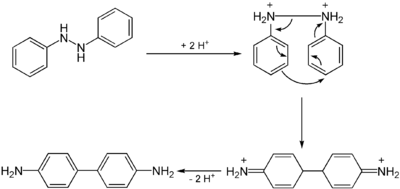- Benzidine
-
Benzidine  4,4'-diaminobiphenylOther namesBenzidine, di-phenylamine, diphenylamine
4,4'-diaminobiphenylOther namesBenzidine, di-phenylamine, diphenylamineIdentifiers CAS number 92-87-5 
PubChem 7111 ChemSpider 6844 
KEGG C16444 
ChEMBL CHEMBL15901 
Jmol-3D images Image 1 - c2c(c1ccc(N)cc1)ccc(N)c2
Properties Molecular formula C12H12N2 Molar mass 184.24 g/mol Appearance white solid Melting point 122-125 °C
Solubility in water 0.94 g/100 mL at 100 °C Related compounds Related compounds biphenyl Hazards Main hazards carcinogenic  (verify) (what is:
(verify) (what is:  /
/ ?)
?)
Except where noted otherwise, data are given for materials in their standard state (at 25 °C, 100 kPa)Infobox references Benzidine, the trivial name for 4,4'-diaminobiphenyl, is the solid organic compound with the formula (C6H4NH2)2. This aromatic amine is a component of a test for cyanide and also in the production of dyes. Benzidine has been linked to bladder and pancreatic cancer.[1] Since August 2010 benzidine dyes are included in the EPA's List of Chemicals of Concern.[2]
Contents
Synthesis and properties
Benzidine is prepared in a two step process from nitrobenzene. First, the nitrobenzene is converted to 1,2-diphenylhydrazine, usually using iron powder as the reducing agent. Treatment of this hydrazine with mineral acids induces a rearrangement reaction to 4,4'-benzidine. Smaller amounts of other isomers are also formed.[3] The benzidine rearrangement, which proceeds intramolecularly, is a classic mechanistic puzzle in organic chemistry.[4]
The conversion is described as a [5,5]sigmatropic reaction.[5][6]
In terms of its physical properties, 4,4'-benzidine is poorly soluble in cold water but can be recrystallized from hot water, where it crystallises as the monohydrate. It is dibasic, the deprotonated species has Ka values of 9.3 x 10−10 and 5.6 x 10−11. Its solutions react with oxidizing agents to give deeply coloured quinone-related derivatives.
Applications
As with some other aromatic amines such as 2-Naphthylamine, benzidine has been significantly withdrawn from use in most industries because it is so carcinogenic. In the past, benzidine was used to test for blood. An enzyme in blood causes the oxidation of benzidine to a distinctively blue-coloured derivative. The test for cyanide relies on similar reactivity. Such applications have largely been replaced by methods using phenolphthalein/hydrogen peroxide and luminol.
Related 4,4’-benzidines
A variety of derivatives of 4,4’-benzidine are commercially produced on the scale of one to a few thousand kilograms per year, mainly as precursors to dyes and pigments.[3] These derivatives include, in order of scale, the following: 3,3'-dichlorobenzidine (CAS# 91-94-1, m.p. 132 – 133 °C), o-tolidine (2,2'-dimethyl-4,4’-benzidine, CAS# 119-93-7, m.p. 130 °C), and o-dianisidine (2,2'-dimethoxy-4,4’-benzidine, CAS# 119-90-4, m.p. 133 °C). 3,3',4,4'-Tetraaminodiphenyl (CAS# 91-95-2, m.p. 178 °C) is a precursor to polybenzimidazole fiber, a high-strength, flame-resistant material.
References
- ^ Known and Probable Carcinogens, Cancer.org
- ^ EPA's action on Benzidine dyes, epa.gov
- ^ a b Hans Schwenecke, Dieter Mayer “Benzidine and Benzidine Derivatives” in Ullmann’s Encyclopedia of Industrial Chemistry, 2005, Wiley-VCH, Weinheim.
- ^ March, J. “Advanced Organic Chemistry” 5th Ed. J. Wiley and Sons, 1992: New York. ISBN 0-471-60180-2.
- ^ H. J. Shine, H. Zmuda, K. H. Kwart, A. G. Horgan, C. Collins, B. E. Maxwell: Mechanism of the benzidine rearrangement. Kinetic isotope effects and transition states. Evidence for concerted rearrangement, in: J. Am. Chem. Soc. 1981, 103, 955–956; doi:10.1021/ja00394a047.
- ^ H. J. Shine, H. Zmuda, K. H. Kwart, A. G. Horgan, M. Brechbiel: Benzidine rearrangements. 16. The use of heavy-atom kinetic isotope effects in solving the mechanism of the acid-catalyzed rearrangement of hydrazobenzene. The concerted pathway to benzidine and the nonconcerted pathway to diphenyline, in: J. Am. Chem. Soc. 1982, 104, 2501–2509; doi:10.1021/ja00373a028
Categories:- Anilines
- IARC Group 1 carcinogens
- Forensic chemicals
- Biphenyls
Wikimedia Foundation. 2010.


